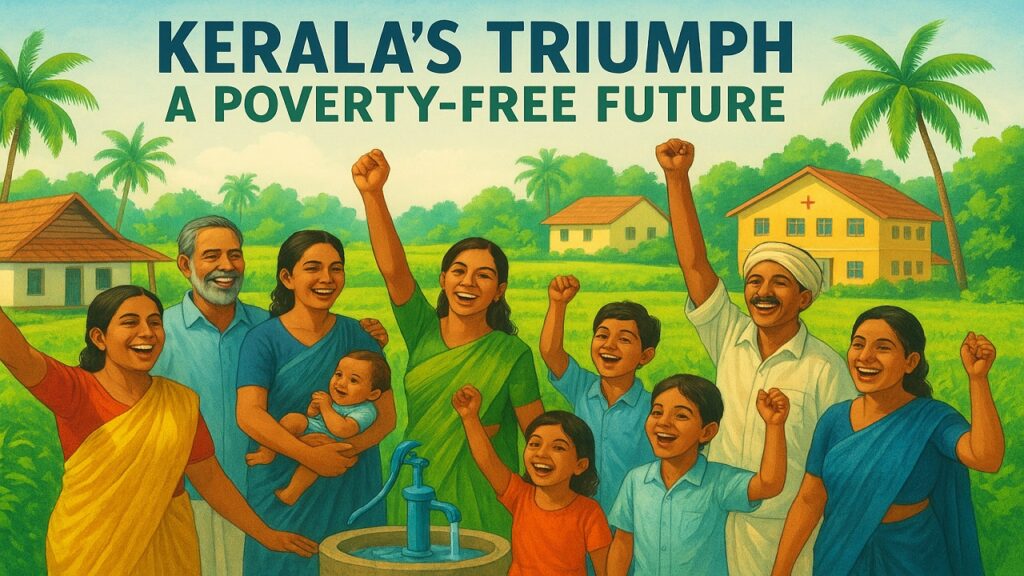Kerala Eradicates Extreme Poverty : A Milestone in Social Development

Context
Recently, Kerala Chief Minister Pinarayi Vijayan announced that the state has eradicated extreme poverty, becoming the first Indian state to achieve this milestone.
This achievement follows a four-year effort under the Extreme Poverty Eradication Programme (EPEP), led by the Left Democratic Front (LDF) government, highlighting Kerala’s long-standing focus on social welfare, education, and healthcare.
The declaration marks a major step in India’s poverty alleviation journey, aligning with the UN Sustainable Development Goal 1 – No Poverty.
Understanding Extreme Poverty
- Definition (World Bank, June 2025): Individuals living on less than $3 per day (2021 PPP) are considered to be in extreme poverty.
- Earlier benchmark: $2.15/day (2017 PPP).
- Poverty line categories:
- Lower-middle-income countries: $4.20/day
- Upper-middle-income countries: $8.30/day
- People earning between $3 and $4.20/day are classified as poor, while those below $3/day are extremely poor.
- It reflects the most deprived population, lacking access to basic human needs like food, shelter, healthcare, and education.
India’s Position in the Global Context
- World Bank (2025): Around 838 million people globally lived in extreme poverty in 2022 (based on $3/day standard).
- India’s progress:
- Extreme poverty declined from 16.2% (2011–12) to 2.3% (2022–23).
- Around 171 million people were lifted out of extreme poverty.
Key Drivers:
- Urbanization and employment growth have played a central role.
- Urban unemployment declined to 6.6% in Q1 FY24–25, the lowest since 2017–18.
Persistent Challenges:
- Unemployment: Youth unemployment stands at 13.3%, and 29% among graduates.
- Gender disparity: Female employment is only 31%.
- Informal employment: Around 77% of non-farm jobs and most farm jobs remain informal.
- Experts caution that official estimates may not fully reflect multidimensional poverty and deprivation.
Multidimensional Poverty Index (MPI)
The Global MPI, based on the Alkire-Foster methodology, uses 12 indicators under three dimensions:
- Health: Nutrition, child mortality, maternal health.
- Education: Years of schooling, school attendance.
- Standard of living: Housing, sanitation, assets, and cooking fuel.
It offers a comprehensive assessment of poverty, going beyond income-based measures.
Kerala’s Journey in Poverty Eradication
- Kerala’s poverty rate fell from 59.8% in the 1970s to near zero in recent years.
- According to MPI 2021, Kerala’s poverty rate was only 0.7%, the lowest in India.
- The achievement is attributed to:
- Strong social welfare policies in education, health, and social security.
- Effective decentralised governance and local-level implementation.
- Kerala’s extreme poverty identification method differed from NITI Aayog’s MPI framework, focusing on locally relevant indicators and data verification.
Extreme Poverty Eradication Programme (EPEP)
Launch: 2021
Nodal agency: Local Self-Government Department (LSGD)
Human resource mobilization:
- Around 4 lakh officials, elected representatives, and volunteers were trained.
Identification process:
- 1.18 lakh families were initially identified.
- Criteria: Income, health, housing, and food insecurity.
Key Interventions:
- Housing: Out of 4,677 homeless families, 4,005 were provided homes under the Life Mission Scheme.
- Food security: 20,648 families lacking stable food access were supported with meals provided by local bodies.
- Essential services: Under the Avakasam Athivegam (Rights Fast) campaign, families gained access to Aadhaar, voter ID, bank accounts, MGNREGS job cards, social pensions, electricity, and LPG connections.
- Institutional collaboration: Effective coordination between local governance, data teams, and communities ensured inclusivity.
- Political support: The programme received cross-party backing, enhancing credibility and reach.
Remaining Challenges for Kerala
- Tribal inclusion concerns:
- The Adivasi Gothra Mahasabha alleged that only 5% of identified families were from Scheduled Tribes.
- High deprivation persists among Paniya, Adiya, and Kattunaikkar tribes in Wayanad and Attappady.
- Criticism was directed at the survey methodology for not including tribal-specific indicators.
- Labour and welfare issues:
- ASHA workers criticized the government’s poverty claims and demanded better pay (₹223/day).
- The government responded by raising their monthly pay by ₹1,000.
- Sustainability of progress:
- The LSGD has launched Phase II to ensure families do not slip back into poverty.
- Focus areas include livelihood generation, skill training, and long-term income stability.
Conclusion
Kerala’s declaration of zero extreme poverty marks a historic milestone in India’s social and economic journey.
The EPEP demonstrates how decentralised governance, data-driven planning, and community participation can produce sustainable and inclusive outcomes.
While challenges of tribal inclusion, employment generation, and welfare sustainability remain, Kerala’s experience serves as a replicable model for other Indian states.
By integrating welfare delivery with dignity, empowerment, and participation, Kerala reaffirms its status as a pioneer in human development and social justice.
Source : The Hindu
